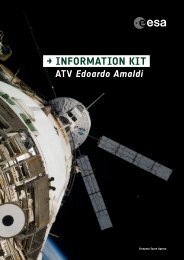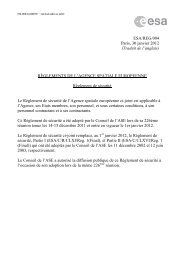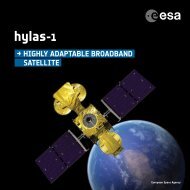→ GSTP ANNUAL REPORT 2011 - ESA
→ GSTP ANNUAL REPORT 2011 - ESA
→ GSTP ANNUAL REPORT 2011 - ESA
Create successful ePaper yourself
Turn your PDF publications into a flip-book with our unique Google optimized e-Paper software.
Ao activities initiated in <strong>2011</strong><br />
Development of a portable, integrated Point-of-Care<br />
Diagnostics Platform for multiplexed Assays<br />
Point-of-Care (POC) medical diagnostics have demonstrated significant utility<br />
in a variety of settings. Most relevant to <strong>ESA</strong>‘s immediate needs is the health<br />
monitoring of astronauts in space.<br />
The goal of this project is to demonstrate the technologies necessary for a<br />
Point-of-Care diagnostics platform for performing hematologic, clinical chemistry<br />
and immunological tests on whole blood. The resulting prototype will<br />
consist of a microfluidic disc, an instrument, reagents that perform a representative<br />
immunoassay and it will carry out the steps for a bead-based<br />
immunoassay with detection in a rotating flow channel.<br />
Three broad technologies must be integrated through this project to demonstrate<br />
a representative assay: bead-based immunoassays, centrifugal microfluidics,<br />
sensor technology and associated optics system. These must<br />
be brought together under unified instrument control. The default detection<br />
system will consist of a laser as an illumination source, an optical system<br />
consisting of custom and commercial-of-the-self components for delivering<br />
radiation to the disc and fluorescence from the disc and the silicon photomultiplier<br />
assembly with integrated filters.<br />
SArAS- fast Satellite Acquisition System<br />
Usually satellite positions can be calculated through the use of orbital propagators.<br />
These positions are then set in the initial pointing of dish antennas<br />
as an aid for fast acquisition. However, those techniques are generally<br />
designed for stable or final orbits, with decreasing precision in some critical<br />
scenarios where too much inherent uncertainty makes the estimation system<br />
less reliable.<br />
The main goal of this Announcement of Opportunity is to develop an acquisition<br />
aid system for large TTC antennas that can work at lower Signal to Noise<br />
Ratios (SNR) than current ones. SARAS project uses phased array antennas<br />
and digital signal processing in order to electronically get an estimate of the<br />
Telemetry signal’s direction of arrival with super-resolution algorithms. Such<br />
an estimate can be obtained in a relatively short time with acceptable accuracy<br />
even at low input SNR.<br />
This project will enable fast acquisition of satellites/launchers in Launch and<br />
Early Orbit Phase. It will allow to speed up the acquisition in operational<br />
stages of satellites in nominal orbits and to obtain the position of closely<br />
spaced satellites<br />
Advanced Particle filters<br />
The objective of this activity is the development of a family of advanced particle<br />
filters for chemical and electric propulsion, qualified for operation. The<br />
filters are developed for absolute ratings in the 2-20 μm range, and for the<br />
most commonly used gaseous and liquid propellants such as Xenon, Nitrogen,<br />
Hydrazine, MON/NTO, and High Performance Green Propellant (HPGP).<br />
The key technology behind the filter disk is MEMS (Micro-Electro-Mechanical<br />
System). The MEMS technology enables manufacturing of well-defined miniature<br />
structures with extreme precision and repeatability. For the filter application,<br />
MEMS technology is ideally suited to manufacture millions of small<br />
channels, passages, holes, etc. in the micron scale with tight tolerances.<br />
Adding to the fact that manufacturing is highly automated and parallel (batch<br />
processing), the filters can be manufactured at reasonable cost.<br />
The activity is in its first phase during which gaseous particle filters should<br />
be built. The second phase of the activity will be dealing with particle filters<br />
for liquid propellants<br />
Gaseous particle filters are frequently used for pressurant gases on the high<br />
pressure side of liquid propulsion systems. The pressurants are normally helium<br />
or nitrogen. Other common applications are found in electric propulsion<br />
systems and cold gas systems using xenon, nitrogen and other inter gases<br />
as propellants.<br />
> Project concept of comsumable disk with reagent<br />
> Sketch of the SARAS system<br />
With the participation of Ireland<br />
With the participation of Spain<br />
With the participation of Sweden<br />
> Bread board model of a MEMS-based stacked-disk filter<br />
<strong>GSTP</strong> Annual Report <strong>2011</strong> | 13

















